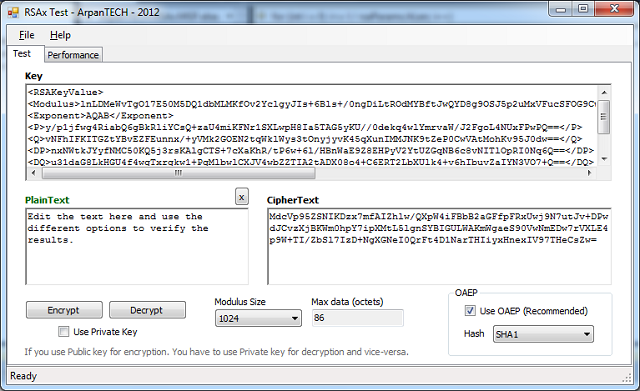Rsa Encryption Program In Java
Popular topics: RSA encryption in Java We introduced the notion of, in which a key needed to encrypt data is made public, but the corresponding key needed to decrypt it is kept private, for example in a file on the server to which clients connect. In principle, such a system solves the problem of how to send a temporary encryption key securely to the server when opening a secure connection. A very common asymmetric encryption system is RSA, named after inventors Rivest, Shamir & Adleman.If we just used a system such as AES on its own, we'd have the problem of how the two parties agree on the key in advance. This is sometimes possible, but usually, we want to transmit a temporary key at the moment of connecting. Generally, we use an asymmetric encryption system such as RSA to transmit the secret key, then for the rest of the conversation, use a regular symmetric encryption system using that secret key. Basic algorithm and terminology RSA encryption and decryption are essentially mathematical operations. They are what are termed exponentiation, modulo a particular number.
Because of this, RSA keys actually consist of numbers involved in this calculation, as follows:. the public key consists of the modulus and a public exponent;. the private key consists of that same modulus plus a private exponent. Those interested in more details of the should see this separate page.
How To Program In Java
Creating an RSA key pair in Java As a one-off process, we need to generate an RSA key pair that from then on, we'll use for all conversations between our clients and server. Creating an RSA key pair essentially consists of picking a modulus, which is based on two random primes intended to be unique to that key pair, picking a public exponent (in practice, the common exponent 65537 is often used), then calculating the corresponding private exponent given the modulus and public exponent. Java provides the KeyPairGenerator class for performing this task.
Rsa In Java
The essential idea is as follows:. we create an instance of KeyPairGenerator suitable for generating RSA keys;. we initialise the generator, telling it the bit length of the modulus that we require (see below);. we call genKeyPair, which eventually returns a KeyPair object;. we call getPublic and getPrivate on the latter to pull out the public and private keys. The code looks as follows. KeyPairGenerator kpg = KeyPairGenerator.getInstance('RSA'); kpg.initialize(2048); KeyPair kp = kpg.genKeyPair; Key publicKey = kp.getPublic; Key privateKey = kp.getPrivate; Notice that we specify a key length of 2048 bits.
Common values are 1024 or 2048. Is a tradeoff between security and performance. We now have two Key objects.


Rsa Encryption And Decryption
Whilst we could immediately use these to start encrypting and decrypting, in most practical uses, we want to store these two keys for later use. For that, we use a KeyFactory to pull out the components (modulus and exponents) of the keys. Saving the public and private key In practice, we need to store the public and private keys somewhere. Typically, the private key will be placed on our server, and the public key distributed to clients.
To store the key, we simply need to pull out the modulus and the public and private exponents, then write these numbers to some file (or put in whatever convenient place). The Key interface allows us to pretend for a second that we don't need to worry about the algorithm-specific details of keys. But unfortunately, in practice we do. So there also exist 'key specification' classes— RSAPublicKeySpec and RSAPrivateKeySpec in this case— with transparent methods for pulling out the parameters that make up the key. Then, a KeyFactory allows us to translate between Keys and their corresponding specification. It's a bit clumsy, but the code ends up as follows.
Comments are closed.